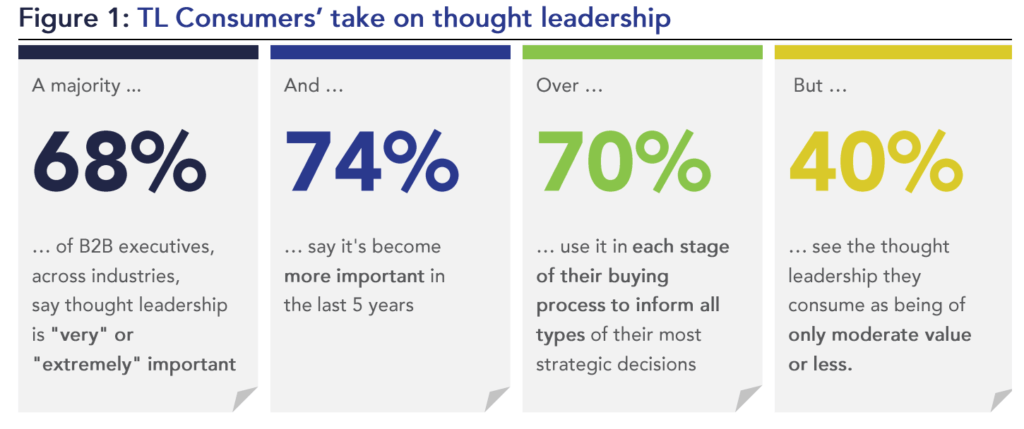Why does fintech thought leadership matter? The 2024 Edelman-LinkedIn B2B Thought Leadership Impact Report provides a compelling answer. The report shows:
- 73 percent of decision-makers see thought leadership as the more trustworthy way to assess a business than its marketing materials and product sheets.
- 75 percent of C-level executives say a piece of thought leadership motivated them to research a product or service they were not previously considering.
- while 40 percent said consistently strong thought leadership by an organization has prompted them to explore its offers or capabilities.
But producing that high quality is much easier said than done. Here are our six simple rules for producing fintech thought leadership that buyers value.
1. Research Your Audience First
Fintech is complex. Content geared towards CFOs, bank CTOs, and enterprise leaders needs to be highly specialized. Research your audience to understand:
- Which experts and research sources they respect
- how much they understand about the topic
- their short and long-term business goals
- who their stakeholders and peers are
- which data they value.
Once you understand your audience, it’s time to take a closer look at the content formats they prefer.

2. Match Content Formats to Audience Preferences
Format choice does matter. A report from Forefront Communications Group shows fintech CMOs rank company-written thought leadership content and third-party research or whitepapers ahead of videos and podcasts. The lasting importance of written content may seem surprising especially considering the rise of short-form video and podcasts. Yet text still carries many advantages.
- Easily skimmable and searchable. Simply skimming an article helps people get to the main point faster than they would with video or audio.
- Long-form can become short-form. For example, the main points from long-form can even be repurposed into short social media posts.
- More SEO-friendly. Long-form content is also more SEO-friendly than podcasts or a video as search engines prioritize content that is comprehensive and topic-focused.
For example, C-suite leaders may prefer case studies and opinion pieces rather than blog posts, meaning you will need to invest in customer interviews. Most of the time, these leaders will be looking for guidance on what to do rather than a snapshot of an industry situation. While your ideal format will ultimately depend on the subject matter and target audience, written thought leadership is here to stay.
3. Serve, Don’t Sell
Thought leadership content is insightful, compelling content meant to pique interest in your company. — The New York Times Company
Thought leadership is a long game. Releasing articles, reports, and whitepapers will not contribute to email sign-ups, website traffic, media mentions, backlinks, or customer relationships right away.
Readers who feel content was only made for promotion will discredit your insights immediately, no matter how well-researched. Avoid the temptation to focus only on the company’s objectives as it is one of the many common self-promotion mistakes for marketers.
Remember: the ultimate goal of thought leadership is to spark a conversation, not to chase conversion.
4. Balance Brand Reputation with SEO Goals
Some of the best thought leadership issues might have low search volumes. Yes, content with the right keywords will be better picked up by Google’s algorithm, diverting a greater amount of traffic to your content and in turn, your company. But sometimes the most interesting — and thoughtful questions — are those that are rarely asked.
Ironically, prioritizing great thought leadership benefits SEO anyway. SEMRush’s guide to thought leadership explains people will naturally want to link to your content if it has valuable opinions, research, and data. This generates likes, shares, and backlinks that strengthen your SEO profile. The key here is to focus on creating content with insights that people will want to share.
5. Build Upon Expert Views with Useful Data
The 2022 LinkedIn-Edelman report makes a solid case for data-backed content too. Almost half of executives say robust research and strong supporting data increase the value of thought leadership.
You can weave data into thought leadership content with:
- Visualizations. Use charts, graphs, and other visualization tools to emphasize certain data points and simplify things for readers.
- Surveys and research. This is a great way to gather your own data you can use for content later on.
- Case studies. Case studies are a powerful way to showcase how data is being used in real-world scenarios to solve problems and drive results.
- Industry reports. Industry reports are a helpful way to glean insights from a bird’s-eye view of your industry.
Be sure content tackling industry issues and buyer interests is backed by rigorous research. Whenever possible, statements should be backed by statistics and quotations from reputable expert sources. This lets readers know your organization has a depth of knowledge and respect for the subject matter and audience.
6. Encourage a Culture of Thought Leadership
Having a strong thought leadership culture is not easy. But the highest performing brands in thought leadership leaders work hard to create them. The Buday Thought Leadership report shows 71 percent of thought leadership front runners credit a strong culture for their impact. The Buday Report suggests thought leadership cultures grow when businesses invest in people, research methodologies, and campaign outreach.
Final Take: Thought Leadership Builds Trust for Fintech
Fintech thought leadership takes time and expertise. And those who do it well can build a positive reputation with prospects, partners, and customers. By establishing your fintech as a thought leader, you’re showing your company can be trusted to solve your customers’ problems.

